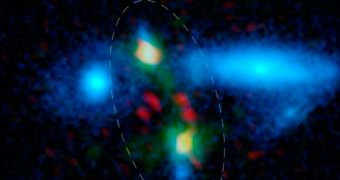The Herschel Space Telescope may be dead, but its legacy lives on. In fact, data captured by the telescope is still being analyzed, providing valuable scientific information.
For example, the telescope captured the very rare merger of two already massive galaxies.
There's a big amount of star formation happening where the two galaxies have already collided, and the two will eventually settle into one super-giant elliptical galaxy.
The finding doesn't only provide a glimpse into the scale at which the universe operates, but also helps solve one of the lingering questions on the formation of massive elliptical galaxies.
The discovery seems to suggest that mergers like these, while not exactly common, can explain the formation of the large galaxies observed in the universe. The other popular theory was that the galaxies grew gradually by accumulating mass, possibly by gobbling up smaller galaxies.
"Mergers are fairly common in the cosmos, but this particular event is unusual because of the prolific amounts of gas and star formation, and the sheer size of the merger at such a distant epoch," NASA explains.
"The results go against the more popular model explaining how the biggest galaxies arise: through minor acquisitions of small galaxies. Instead, mega smash-ups may be doing the job," it adds.

 14 DAY TRIAL //
14 DAY TRIAL //